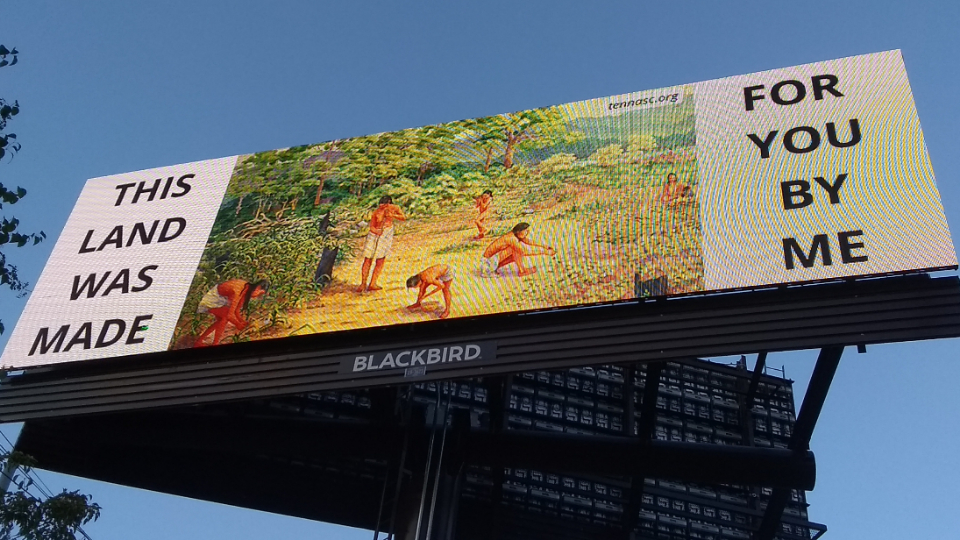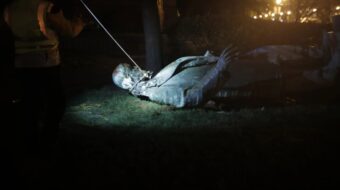
NASHVILLE—A trip on Nashville’s Interstate 65-North at Exit 92 showcases the ancient Native history of the city by way of historic billboard presentations. There are three rotating images highlighting the Indigenous Mississippian culture that flourished in the area 1,000 years ago.
So far as is known, this is the first digital billboard, or in fact any billboard, depicting Nashville’s abundant ancient Native history.
The purpose of the installation is to bring awareness to the mainstream public of the complexity and magnificence of ancient Indigenous culture in the Nashville area that was all part and parcel of the Mississippian civilizations.
The images are meant to provide thought-provoking awareness of the highly developed but relatively little known ancient civilization of Indigenous Middle Tennessee, in general, and of Nashville in particular.

This ancient polity was the residence of tens of thousands of Indigenous inhabitants. In fact, it is estimated that the population of Mississippian Nashville hovered around 400,000. Modern-day Nashville’s population did not eclipse this demographic until 1966, with a figure of 407,000 residents, as is pointed out in one of the billboard depictions.
Ancient Nashville was only one of the great cities that abounded throughout the eastern half of North America, including the Midwest and the Southeast. The inhabitants shared overlapping religious and political ideologies and extensive trade networks.
It is now generally surmised that these magnificent cultures were the result of the energies of not just one people, but of a combination of tribal ethnicities working together. These cities are now lauded as comparable to those of the Aztecs and Mayas.
Also, most Mississippian urbanities had their own distinctive characteristics. Ancient Nashville stands out as a dense population center, with the largest Indigenous population of its time in the entire Southeast.
This area, along with other Mississippian urban centers, contained large numbers of earthen mounds further attesting to the existence of vast populations. These cities often had as many as a hundred or more massive earthworks, with spacious, sweeping plazas and towering, awe-inspiring temples. There is much speculation that these centers functioned as city-states that controlled entire regions.
But what is of cardinal importance is the recognition that these great cities, filled with millions of inhabitants, existed hundreds of years before the avaricious advent of invading Europeans. They were the manifestations of brilliant, advanced civilizations. These cosmopolitan metropolises were typically larger and immensely cleaner (the Indigenous were noted by European colonists for their high level of hygiene) than London or Paris of the same historical epoch.
How these billboards came to fruition is a novel story in itself. It all began with a community member, Jackie Pretends Eagle, winning free billboard space from Blackbird Media in October 2021. She participated in a silent auction in hopes of presenting Indigenous billboard images for her children.

Pretends Eagle contacted this writer for suggestions after she won. In the meantime, Jana Harper, Associate Professor of the Practice, Department of Art, Vanderbilt University, who is also a member of the Mackinac Bands of Chippewa and Ottawa Indians, was looking for a way to portray the ancient Indigenous history of Nashville in a public venue.
This dovetailed into an immediate agreement with Pretends Eagle for images on the billboard done by students from her Text and Image Art class. The students who participated in the billboard project included Noah Ford, Ryan Keenan, Jeanette Hurvitz, Kielan Watson, Keke Huang, and Jasmine Cobbinah.
Two of the three designs feature artwork by acclaimed artist Carlly Urello, who has worked with the Tennessee State Museum to create paintings depicting the lives of the ancient Indigenous inhabitants of Middle Tennessee.
A third image depicts the massive earthwork at Mound Bottom State Archaeological Area, a state archaeological site just west of Nashville. This image includes the adage that “Mississippian Mounds are Wonders of the World” and says that construction of the mound required 76,000,000 lbs. of earth to be moved by hand. This was constructed in 1000 A.D.
The images were chosen in consultation with the American Indian Coalition and others in the community.
The billboard images are fitting depictions of a history that is so glorious, but so little known, of ancient Native America, and they dispel many racist stereotypes that still abound about pre-Columbian America. The images will be up until the end of September.










